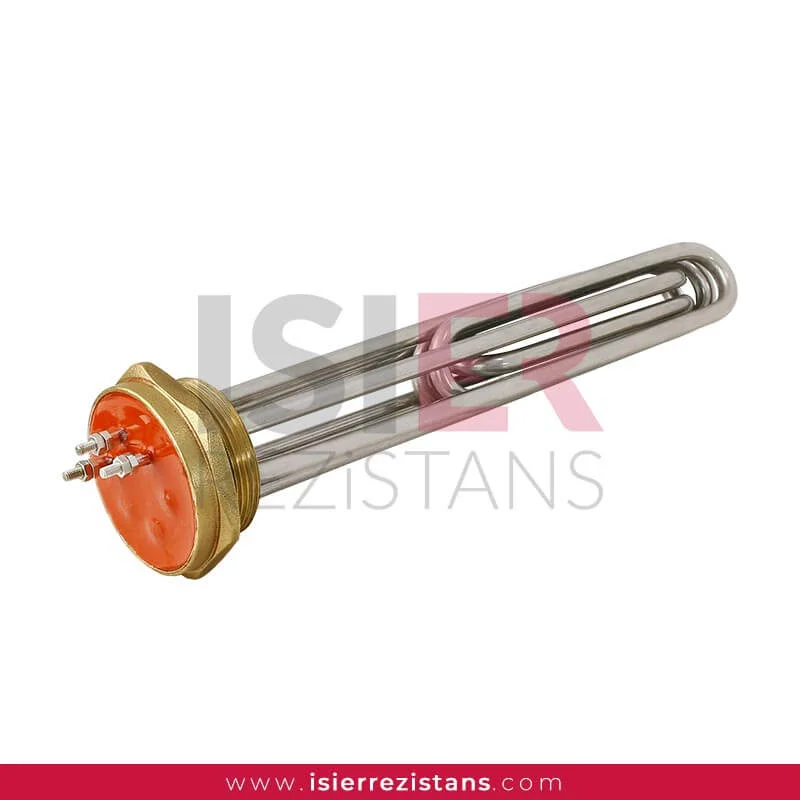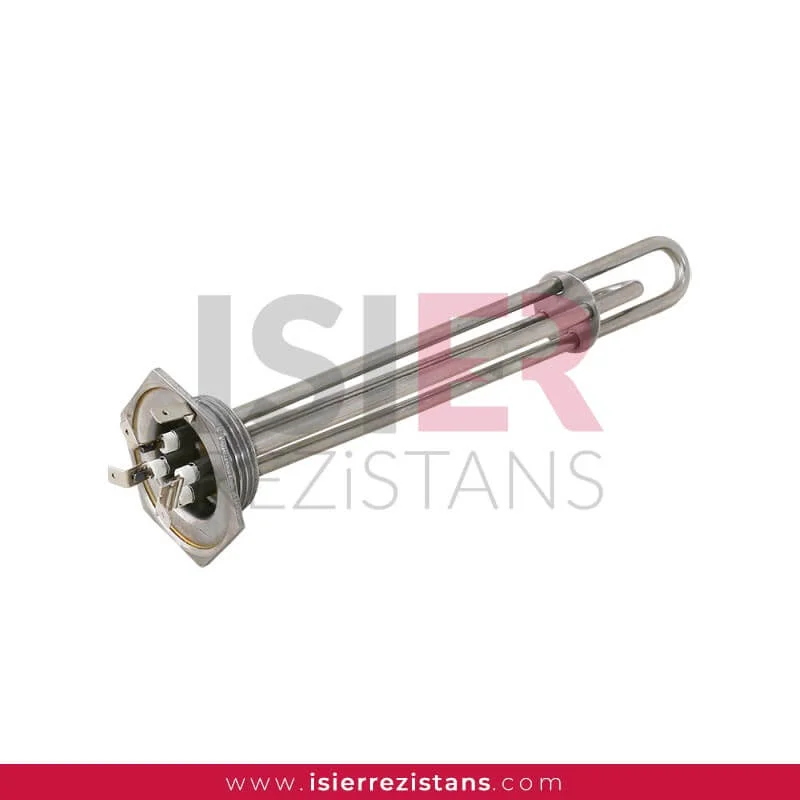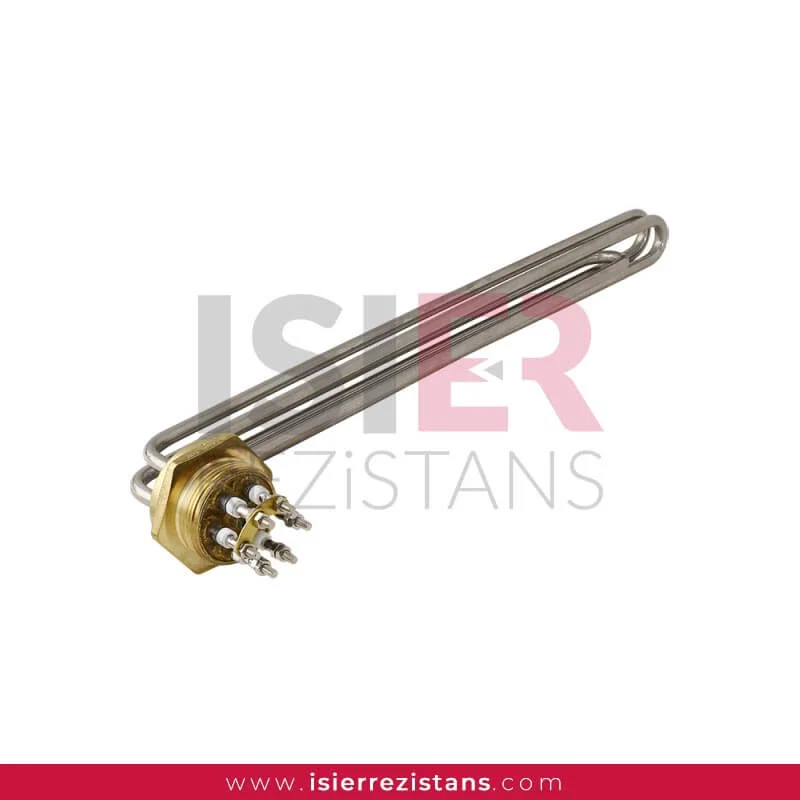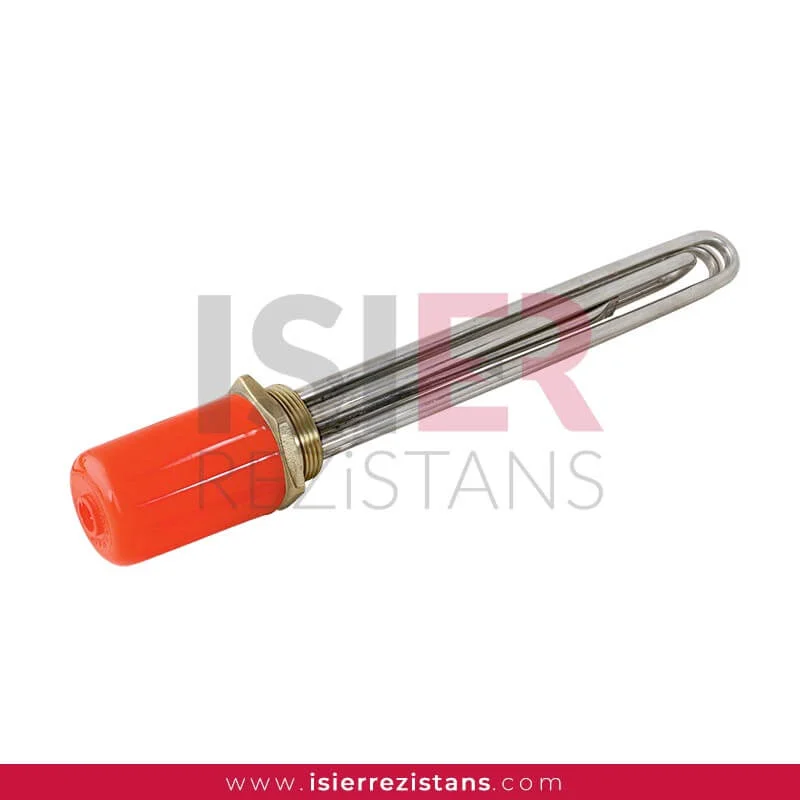Head Heaters
Cartridge heaters are special types of heating elements that provide effective and reliable solutions in industrial heating applications. These specially designed heaters have a wide range of uses in many sectors, and are particularly preferred in applications requiring specific temperature control and durability.
Working Principle
Headed heaters generally have a compact structure with a ceramic or metal head containing a special heating element. This head optimizes heat transfer as it directly contacts the area where the heater will be mounted. The design of headed heaters ensures stable performance in operations by providing rapid and homogeneous heat distribution.
What are the Technical Specifications of Head Heaters?
The technical specifications of headed heaters can vary depending on their intended use and application requirements. However, generally, the technical specifications of headed heaters include the following elements:
1. Nominal Power (Watt): Headed heaters have a nominal power that represents a specific heating capacity. This power represents the heating capacity per unit length or area of the heater.
2. Nominal Voltage (Volt): The operating voltage of the heater is typically specified, indicating the voltage at which the heater operates. Common voltages for most industrial applications include 120V, 240V, and 480V.
3. Nominal Current (Ampere): The operating current of the heater represents the electrical current consumed when operating at a specific voltage. This value varies depending on the design power of the heater and the circuit voltage it is connected to.
4. Material and Coating: The heating elements of headed heaters are typically nickel-chromium alloys. Ceramic or special coatings may be used to enhance durability, provide chemical resistance, or meet specific application requirements.
5. Temperature Range: The operating temperature range of the heater specifies the temperature values at which it is suitable for a particular application. This reflects the heater’s ability to effectively operate under extreme temperature or low-temperature conditions.
6. Length and Diameter: The physical dimensions of headed heaters are important to fit the mounting area. Length generally represents a specific dimension in the heater’s working area, while diameter indicates the width of the heater.
7. Connection Type: The mounting and connection types of headed heaters are important for ease of use and integration. These may include flange connections, threaded connections, or other special connection types.
8. Protection Class (IP Rating): The IP rating indicating the protection level of the environment where the heater will be used is crucial. This rating specifies the levels of protection against dust, splashes, and water ingress.
These technical specifications encompass the key elements that determine the performance, compatibility, and durability of headed heaters. Relevant technical specifications assist users in selecting a headed heater suitable for a specific application or industrial need.
In Which Sectors Are Head Heaters Used?
Headed heaters are versatile heating elements used in various industrial applications. These specially designed heaters are preferred in many sectors due to their advantages such as specific temperature control, durability, and homogeneous heat distribution. Here are some sectors where headed heaters are commonly used:
Metal Processing Industry: Used for heating and shaping metal parts in metal forming, heat treatment, and tempering processes.
Plastics and Rubber Industry: Utilized for heating and shaping plastic materials in plastic injection machines and extrusion systems.
Food Industry: Employed for cooking and processing materials in ovens, stoves, grills, and other food processing equipment.
Chemical Industry: Used for heating chemical reactors and ensuring specific temperature conditions in chemical processes.
Electronic Industry: Used as heating elements in soldering stations, testing equipment, and other electronic manufacturing processes.
Laboratory Applications: Utilized in laboratory devices and experiments where specific temperature conditions need to be controlled.
Heating, Ventilation, and Air Conditioning (HVAC): Can be used for heating air and liquids in HVAC systems.
Paper and Pulp Industry: Preferred for drying paper in paper production machines.
Agriculture and Livestock: Used for heating water, heating animal shelters, and other agricultural applications in farming facilities and animal farms.
Energy Production and Plants: Preferred for heating water or other liquids in boiler systems and energy production facilities.
Automotive Industry: Used for processing automotive parts in paint drying ovens and other heat treatment applications.
Maritime and Shipbuilding: Utilized for heating water or other liquids in the marine industry, maritime vessels, and maritime applications.
The wide range of applications and versatility of headed heaters in industrial heating systems make this type of heater an important heating solution in many different sectors.
Why Should You Prefer Heater Heads?
Headed heaters are preferred heating elements in many industrial applications for the following reasons:
Homogeneous Heat Distribution: Headed heaters provide homogeneous heat distribution due to their special design, allowing for a more stable temperature profile in the application area.
Fast Heating Capability: The use of high heat capacity materials such as nickel-chromium alloys enables headed heaters to heat up quickly. This feature allows for faster and more efficient processes.
Durability and Longevity: Headed heaters are typically made from nickel-chromium alloys protected by special coatings or durable materials, enhancing their durability and providing long-lasting performance.
Design Flexibility for Special Application Requirements: The design of headed heaters offers flexibility to accommodate special application requirements, enabling a wide range of applications across different sectors and industrial processes.
Temperature Control and Monitoring Capabilities: Headed heaters can be integrated with temperature control and monitoring systems. This feature can be used to meet special needs such as providing specific temperature conditions or issuing alerts in case of overheating.
Various Connection Options: This type of heater comes with various connection options, making installation and integration processes easier.
Energy Efficiency: The fast heating capability and homogeneous heat distribution of headed heaters enhance energy efficiency, helping to optimize energy costs in processes.
Diverse Industrial Application Areas: Headed heaters have a wide range of applications in various industrial sectors including metal processing, plastic injection, food production, chemical processes, electronic manufacturing, and more.
Ease of Integration: They can be easily integrated into different industrial systems, aiding businesses in adapting to their existing equipment.
These advantages of headed heaters lead many users seeking reliable and effective solutions in industrial heating systems to prefer them.
In which sectors oven heaters are used
Heater elements are heating elements widely preferred in many areas within a broad spectrum of usage. Here are the common areas where heater elements are extensively used:
Home Ovens: Household ovens use heater elements to heat the air inside or the oven surface, allowing food to be cooked. These ovens are typically used in home kitchens, and heater elements are integrated into various home oven models.
Industrial Ovens: Industrial ovens are used in large-scale manufacturing facilities, industrial establishments, or laboratories. Heater elements heat the interior of industrial ovens to cook, dry, or process materials.
Pizza Ovens: Restaurants or pizzerias use specially designed heater elements in pizza ovens. These elements enable pizza ovens to operate at high temperatures, allowing pizza dough to cook quickly and effectively.
Oven Ranges: Heater elements support oven functions in kitchen ranges found in household kitchens. These ranges are used to diversify cooking processes.
Gastronomy and Catering: Large events, weddings, or catering services require cooking large amounts of food. Heater elements are used in industrial ovens and large kitchen appliances for such applications.
Bread Ovens: Heater elements are used in bread ovens where bakery products (bread, pastries, etc.) are baked. These ovens are typically equipped with heater elements to ensure bread is baked at the desired temperature and evenly.
Laboratory Ovens: Laboratory ovens used in scientific and research laboratories operate with heater elements. These ovens are used to process, dry, or test materials at specific temperatures.
Heating and Drying Applications: Heater elements are commonly used in industrial applications for heating or drying materials. These applications can be found in metal processing, ceramic production, the food industry, and many other fields.
Heater elements play a significant role in various sectors due to their wide range of applications. They provide a reliable heating solution to achieve and maintain desired temperature levels.
Head Heaters
Technical Details of Head Heaters
Head heaters are heating elements commonly used in industrial applications, heating systems, and specialized equipment. These heaters have a connection point located at the head of the heating element. They are designed with various structural features depending on their intended use and are known for their durability and high efficiency.
1. Structure of Head Heaters
Head heaters typically consist of metal or alloy wires (such as Nichrome, Kanthal, etc.) that generate heat when an electrical current passes through them. The heating wire is formed into a specific shape, with a connection point added at the head, ensuring compatibility with the surface where it will be installed.
Head Structure: One end of the heater is fitted with a special head, which may contain connection elements such as flanges or screws.
Connection: Electrical connections are usually made using screws, flanges, or socket-type connectors.
Material Selection: These heaters are made from high-temperature-resistant metal alloys such as Nichrome, Kanthal, and stainless steel, ensuring durability and performance in extreme conditions.
2. Working Principle
Head heaters generate heat by passing an electric current through the resistance wire. The electrical resistance within the wire converts electrical energy into heat, which is then transferred to the environment through the head.
Electrical Resistance: The amount of heat generated depends on the resistance of the wire. Higher resistance results in greater heat production.
Heat Transfer: The generated heat is transferred through the head, which helps distribute it effectively to the surrounding area.
3. Application Areas
Head heaters are widely used in the following applications:
Heating Devices: Electric heaters, hot water systems, and industrial heating units.
Steam Machines: Commonly used in machines that generate steam for various industrial processes.
Temperature Control Systems: Provides continuous heating until the desired temperature is achieved.
Plastic Processing Machines: Used in plastic injection molding and extrusion machines.
Laboratory Equipment: Used for heating purposes in chemical and biological laboratories.
4. Advantages of Head Heaters
High-Temperature Resistance: Designed to withstand high temperatures, making them ideal for industrial applications with demanding heat requirements.
Easy Installation and Connection: The connection point in the head facilitates quick and hassle-free installation, maintenance, and replacement.
Durability: Made from high-strength materials to withstand mechanical stress and ensure long-term usage.
Efficient Heat Distribution: The head structure helps distribute heat evenly to the desired area, improving overall heating performance.
5. Usage and Maintenance
Maintenance: Head heaters should be inspected periodically to check for wear and damage, especially at the connection points.
Temperature Control: Integrated with thermostats or temperature sensors to maintain a stable heating level and prevent overheating.
Energy Efficiency: These heaters provide efficient energy conversion, reducing overall energy consumption while maintaining optimal performance.
6. Dimensions and Design of Head Heaters
Head heaters can be customized in various dimensions based on the application requirements and heating capacity. The design considerations include:
Wire Length and Diameter: The heating capacity is directly affected by the length and diameter of the heating wire.
Head Type: The type of connection elements used in the head can vary (e.g., screw type, flange type).
Heat Capacity: The power capacity of the heater is determined based on the size of the heating environment. This is measured in watts and typically ranges from 50W to 5000W.
Head heaters are electric heating elements that provide high-temperature resistance, durability, and efficiency. They are used in various industrial applications tailored to the structural design of the equipment. Offering effective heating, energy efficiency, and long service life, head heaters present a reliable solution for heating applications across multiple sectors.
Measurement Details of Head Heaters
Head heaters are heating elements used in various industrial and commercial applications. They are designed to generate heat within a specific area and are known for their high efficiency and durability. The dimensions, design, connection components, and intended use of head heaters may vary. Below are general details regarding the measurement aspects of head heaters:
1. Wire Diameter and Length
Wire Diameter: The diameter of the wire used in head heaters typically ranges from 0.5 mm to 8 mm. Wire diameter directly affects the electrical resistance and heating capacity of the heater.
Thicker wires produce more heat, while thinner wires provide lower heating capacity.
Wire Length: The length of the wire determines the heating capacity of the head heater. Depending on the application, wire lengths can range from 10 cm to 2 meters. The length may be adjusted based on the specific heating requirements.
2. Head Size and Design
Head Height: The height of the head section containing the connection components typically ranges between 20 mm and 100 mm. The head size is determined according to the installation space and type of connection elements used.
Head Diameter: Usually varies from 10 mm to 80 mm, depending on the type of connection components and the materials used.
Connection Elements: Head heaters can have different connection types, including screwless, flanged, or socket-based designs. The connection type depends on the diameter and design of the head.
3. Power Capacity
The power capacity of head heaters generally ranges between 50W and 5000W. The power is determined by factors such as wire length, wire diameter, material used, and head design.
Low-power head heaters are used in small areas with low heating requirements.
High-power heaters are used in large industrial machines and applications requiring intense heating.
4. Voltage and Electrical Specifications
Head heaters are designed to operate at voltages ranging from 12V to 480V. The voltage requirement depends on the application needs.
Low-voltage systems are typically used in portable and small-scale devices.
High-voltage systems are utilized in industrial machinery.
5. Heating Element Size and Capacity
Height: The heating element height typically ranges from 10 mm to 150 mm, which can be customized based on the installation area and connection placement.
Outer Diameter: Usually varies from 10 mm to 80 mm, adapted according to the installation environment and heating capacity requirements.
6. Material Selection
The material properties of head heaters play a crucial role in temperature resistance, electrical conductivity, and durability. The most commonly used materials include:
Kanthal: A durable alloy capable of withstanding temperatures up to 1000°C.
Inox (Stainless Steel): Preferred for its thermal resistance and long-term durability.
Aluminum: Used for lightweight applications where weight reduction is a priority.
7. Additional Measurement Details
Connection Screws and Placement: Connection screw sizes and placement are typically standardized to M5, M6, or M8 thread sizes. The screw placement can be customized based on application needs.
Temperature Sensors and Thermostats: Some head heaters feature built-in thermostats or temperature sensors to regulate heat at a specific level and ensure precise temperature control.
Head heaters are high-efficiency heating elements used in various industrial applications. Their size, design, and technical specifications can be customized according to the intended application. These measurement details may vary depending on the manufacturer and application requirements. Selecting high-quality materials and appropriate dimensions ensures efficient operation and long service life for head heaters.
Head Heaters
Head heaters are commonly used in applications such as hot water systems, industrial heating, and drying processes. These heaters are equipped with special metal heads that efficiently transfer heat directly to the connection points. The head design ensures safe and efficient electrical connections.
Head heaters are typically made from stainless steel, copper, aluminum, and ceramic materials. These materials are highly resistant to high temperatures, corrosion, and abrasive conditions. The outer part of the head is usually coated with stainless steel for added durability.
Head heaters offer advantages such as high-temperature resistance, energy efficiency, long lifespan, and rapid heating. They are user-friendly due to their easy installation and maintenance features. The head design enhances electrical connection safety and requires less space.
Head heaters are widely used in various industries, including food processing, industrial heating systems, metal processing, plastic production, baking, and drying applications. They are also commonly found in household hot water systems.
Maintenance of head heaters involves cleaning lime deposits, checking electrical connections, and ensuring insulation integrity. Water-based cleaning agents can be used for cleaning. Accumulated dirt and deposits around the heater can reduce efficiency; therefore, regular cleaning is recommended.
Head heaters provide rapid heating due to their high energy efficiency. Most models can reach the desired temperature within 1-3 minutes after starting the heating process. However, the heating time may vary depending on capacity, material, and connection systems.
Safety measures for head heaters include thermal fuses to prevent overheating, grounding connections, and overcurrent protection. Proper electrical insulation should be ensured. Regular maintenance and inspections are crucial for safe operation.
The durability of head heaters depends on the quality of materials used, operating conditions, and maintenance frequency. Generally, a high-quality head heater can operate efficiently for 5 to 10 years. Regular maintenance extends its lifespan.
Energy consumption of head heaters can be optimized by improving insulation, using temperature control systems, and applying efficient connection techniques. Additionally, digital thermostats can be used to regulate temperature and increase energy efficiency.
Head heaters are typically installed using modular connections. During installation, it is essential to ensure secure electrical connections and proper grounding. External insulation and ventilation arrangements should also be appropriately implemented.












